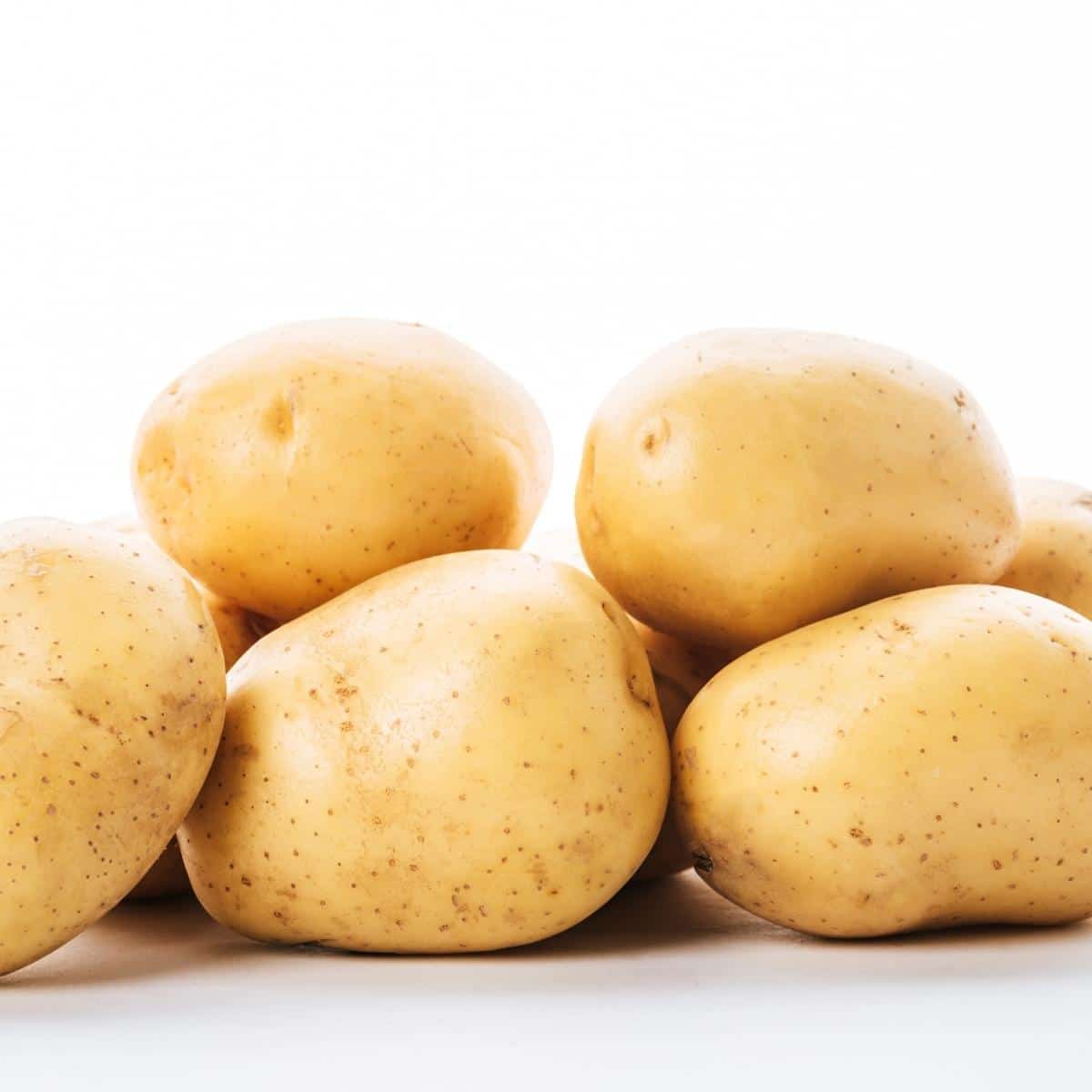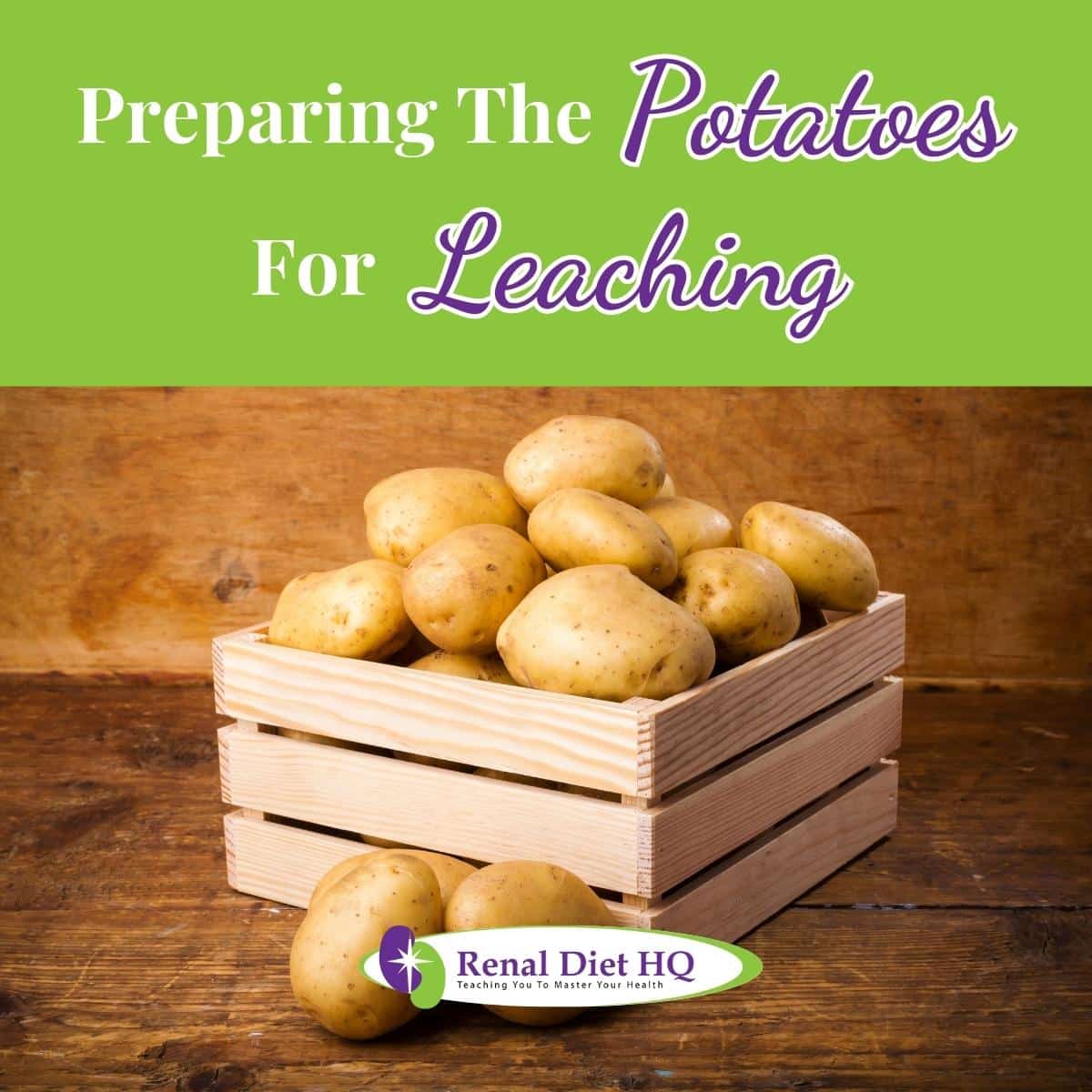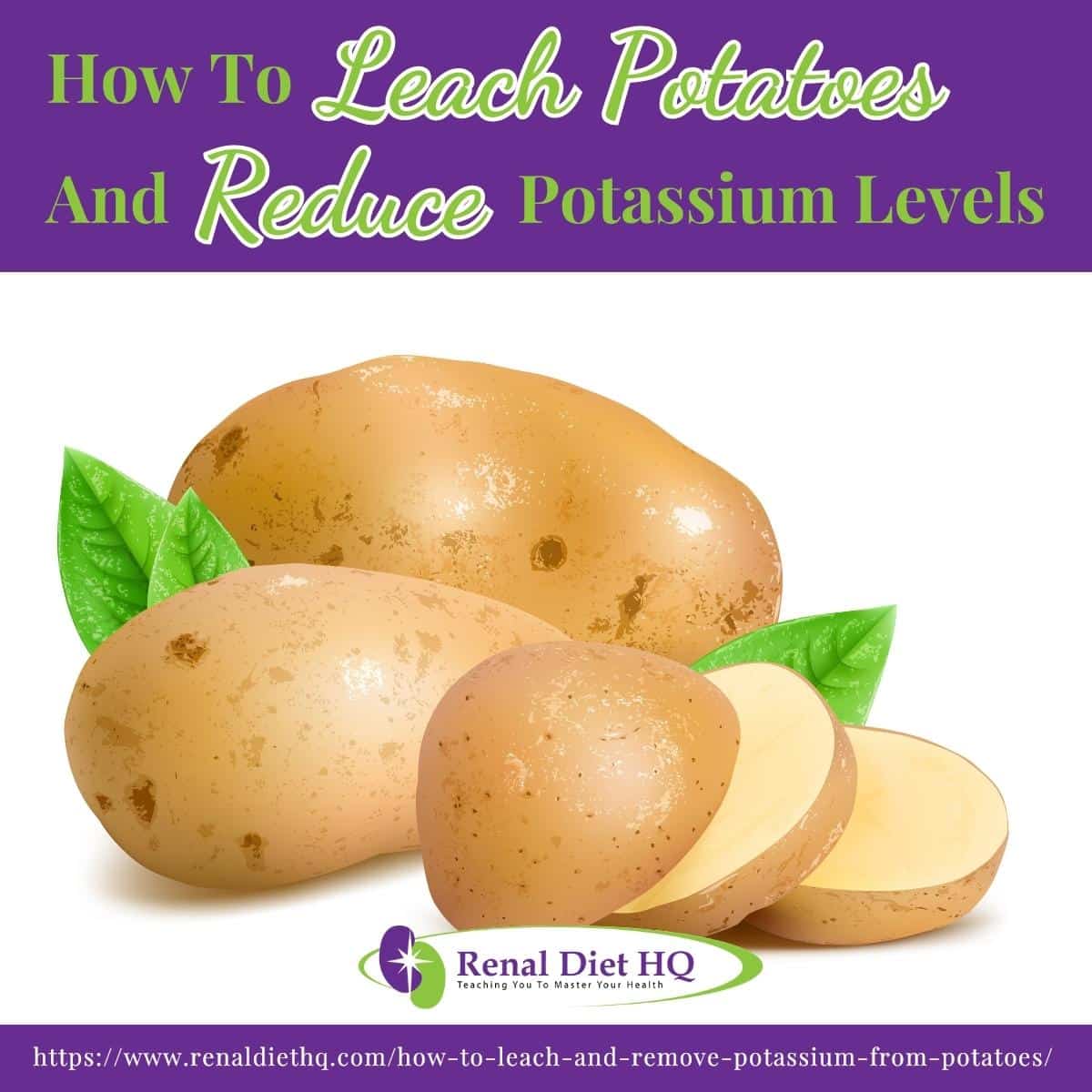How to Leach and Remove Potassium From Potatoes
Do you have high levels of potassium in your potatoes? Are you looking for an effective way to reduce the amount of potassium in them on a renal diet? Leaching is a popular and time-tested method that can help lower the level of potassium potatoes contain.
It's simple, easy, and fast for those with chronic kidney disease! In this article, we'll discuss how to leach potatoes to reduce their potassium levels.
Potassium is an essential mineral for our bodies; however, too much of it can be unhealthy, particularly in renal patients. Fortunately, with careful preparation, we are able to enjoy delicious potatoes while still reducing our risk of consuming too many milligrams of potassium. What happens if your potassium levels are high?
By utilizing the process of leaching, we can remove some of the extra minerals from the potato before eating it. So let's dive into exactly what needs to be done for successful potato leaching! Also, take the time to learn facts about Chronic Kidney Disease to help you in your journey.
As a Registered Dietitian with over 25 years of experience in renal nutrition, I guide individuals with Chronic Kidney Disease (CKD) on how to safely enjoy foods like potatoes while managing their potassium intake.
My recommendations are rooted in evidence-based guidelines to help CKD patients reduce excess potassium through proper preparation techniques like leaching. At Renal Diet HQ, I provide expert, research-backed advice to make kidney-friendly eating both practical and enjoyable.

Leaching requires only two ingredients: water and time. All you need to do is soak a peeled or chopped batch of fresh potatoes, canned potatoes, a white potato, any other forms of potatoes, or other veggies in cold water overnight so that most of the excess minerals wash away.
Afterward, drain off all the liquid and rinse again with fresh pot of water until no more foam appears on top - then you're ready to cook up a batch of potatoes that are perfectly safe and low-potassium with one of the easiest cooking methods! Make sure you have the right kitchen tools and equipment on hand.
Jump to:
- Understanding Potassium Levels
- Health Benefits Of Reduced Potassium Levels
- What Types Of Potatoes Have The Least Potassium?
- What Is Leaching?
- How To Leach Potassium From Potatoes
- How To Leach Potatoes
- Steaming Or Boiling
- Pressure Cooking
- Soaking In Water
- Storing And Reheating The Potatoes After Leaching
- Alternative Ways To Lower Potassium Levels In Food
- How Much Potassium Is Removed From Potatoes During Leaching?
- The Pros And Cons Of Potato Leaching
- FAQs for Leaching Potatoes
- Leaching Potatoes Is Great To Reduce Potassium
Understanding Potassium Levels
Understanding potassium levels and the content in potatoes on a kidney diet is essential for anyone looking to learn how to leach potatoes in water and reduce their potassium intake. Potassium plays a vital role in regulating bodily functions, from nerve signals to muscle movements.
When the body's potassium levels are too low or too high, serious health problems can occur. A healthy human diet should include foods that provide adequate amounts of this minerals in potatoes.
However, sometimes it can be difficult to achieve the recommended daily mineral content through kidney-friendly food alone.
This is why learning how to leach potatoes is an important tool for getting a reduction in potassium content and increasing your mineral intake.
Leaching out excess potassium present in potatoes allows individuals with dietary restrictions due to elevated blood levels of this mineral to still enjoy them as part of their meal plan.
Potato varieties differ greatly in terms of their nutrient content, so understanding which type has the highest level of potassium will help determine which one needs more attention when preparing meals.
Additionally, soaking potatoes before cooking them helps release some of the minerals - including draining the source of potassium and phosphorus- into the water which then need to be discarded afterwards. There are so many low potassium side dishes that you can enjoy!
Finally, boiling potatoes instead of frying them also reduces the overall amount of this mineral retained by the vegetable once cooked. With these tips in mind, those looking to lower their potassium intake can do so without sacrificing flavor or nutrition from this nutritious vegetable!
For More Recipes and Ideas --->> Get Your Free Meals and Recipes That Are Perfect for Pre-Dialysis Diets, Pre-Dialysis with Diabetes, or Dialysis Diets.
Health Benefits Of Reduced Potassium Levels
Reducing potassium intake is also particularly important for individuals with kidney disease because the kidneys play a crucial role in regulating potassium levels in the body.
When the kidneys are not functioning properly, potassium can build up in the blood, which can lead to a condition called hyperkalemia. Hyperkalemia can cause a range of complications, including irregular heartbeat, muscle weakness, and in severe cases, cardiac arrest.
A healthcare provider or a registered dietitian can help to determine an appropriate potassium intake that meets the individual's specific nutritional needs and restrictions when dealing with kidney disease management.
What Types Of Potatoes Have The Least Potassium?
According to a research study on potassium levels in raw potatoes, the Idaho potato was shown to have the least potassium, with the Viking purple potato having the most.
Raw Idaho potato – 259 mg
Raw Sweet potato – 438 mg
Raw Viking potato – 448 mg
What Is Leaching?
Leaching is a process that uses liquid to extract certain compounds from an object. It's a simple method used in many industries and for different purposes, including food processing. In this case, we'll look at leaching potatoes to reduce their potassium levels.
The leaching process involves immersing the potato into water or another solution which can absorb its nutrients.
As the solution seeps through the potato, it takes with it some of its minerals such as potassium and phosphorus, both of which are typically restricted in kidney patients.
This reduces the overall amount of potassium and phosphorus in the potato, making it suitable for those on renal diets.
This technique has been used by farmers since ancient times, but modern methods have made it more efficient and easier to use than ever before.
By controlling the temperature and during leaching, you can determine how much nutrient will be removed from your potatoes. The result? Delicious potatoes without all the extra potassium for those with chronic kidney disease!
View this renal diet food list to get a better idea of what works on this diet and what doesn't.

How To Leach Potassium From Potatoes
As we discussed in the previous section, leaching is a process used to remove substances from solid materials. Now it's time to prepare the potatoes for this life-saving process!
Step 1 – Peel and Cut
The first step to leaching potassium from potatoes is to select large potatoes, wash, peel, and cut them. You want to cut them in thin slices or grate them to get the levels of potassium leached out by the volume of water.
Step 2 – Prepare the water
Leaching requires the potatoes to be placed in water, but there are several different options one has regarding the temperature of the water. A critical facet of this is to have a large amount of water compared to the number of potatoes.
So, you will fill a large pot with warm or room temperature water and then place your potatoes in it. Ideally, you want the water to be warm because it will allow you to leach more potassium out.
You will also want at least ten times the volume of water compared to your potatoes. Do not leach in cold water as little leaching will occur, and it will not be as helpful.
Step 3 – Soak or Boil the potatoes
There are two effective ways of reducing potassium in potatoes, soaking for the leaching or quick boiling them. Leaching is slightly less effective at removing potassium and takes quite a bit longer than quick boiling. However, leaching by soaking is quite easy.
You will just soak your cut or grated potatoes in the warm water for anywhere from 2 to 4 hours, ensuring the water maintains a slightly warm temperature throughout.
Quick boiling is exactly what it sounds like and only requires you to boil your cut potatoes for 10 minutes to leach out about half of the original amount of potassium in the potato.
Now your potatoes are ready for leaching! Here is a quick bullet point list of what has been done:
- Selected large potatoes
- Washed thoroughly
- Cut into small pieces
- Boiled in hot water for 10 minutes
- Drained off soaking liquid
When preparing potatoes for leaching, one must keep these steps in mind in order to achieve successful results! Following these simple instructions ensures maximum efficacy while also helping reduce risk factors associated with improper preparation methods such as contamination or nutrient loss due to over-soaking or inadequate washing techniques.

How To Leach Potatoes
Leaching potatoes is a great way to reduce their potassium levels. There are three different methods for leaching potatoes with minimal effort. Here's an overview of the three main ways to leach potatoes.
| Method | Pros | Cons |
| Pressure Cooking | Fastest method Easiest cleanup | Potatoes absorb cooking liquid More expensive equipment needed |
| Boiling Potatoes | Inexpensive Easy setup | Long process Difficult to monitor progress |
| Soaking Potatoes | Low cost | Time consuming |
Pressure cooking potatoes is the quickest way to leach them. You just need to place the diced or sliced potatoes inside a pressure cooker, add water and cook on high heat until they’re soft.
The only downside is that the potatoes will absorb some of the cooking liquid, making them slightly less flavorful. This method requires more expensive kitchen equipment compared to boiling or soaking potatoes.
Boiling your potatoes offers an inexpensive option without needing any special equipment. To start, you must dice or slice the potatoes and boil them in plenty of water for about 10 minutes before discarding it all - this helps remove some of their starchiness.
Additionally, you may want to repeat this step multiple times if you're looking for even more reductions in potassium levels.
The third option is soaking your diced or sliced potatoes in cold water overnight - up to 8 to 24 hours - which is one of the most affordable methods available out there. While long and tedious, it slowly draws out starches and minerals like potassium over time.
In summary, when considering how best to leach those spuds and reduce their potassium levels — whether it's through pressure cooking, boiling, or soaking — we hope these tips have given you something useful towards helping make healthy meals for yourself and others around you!
Steaming Or Boiling
The process of preparing potatoes is an art. With thoughtful consideration and careful planning, one can ensure that their potatoes are cooked to perfection. Steaming or boiling are two popular methods for cooking potatoes and reducing potassium levels in the process.
Each method has its own unique benefits:
Steaming - This technique creates light, fluffy potatoes that retain more vitamins than boiled alternatives. The steam cooks the potato quickly and evenly, allowing it to absorb less water during the cooking process.
Boiling - Boil cooking requires a shorter cook time than steaming but provides a softer texture and deeper flavor profile. It also helps decrease the glycemic index of starches within the potato making them easier to digest.
Steam Cooking - Steam cooking allows you to prepare multiple types of food at once while preserving essential vitamins, minerals, and phytonutrients compared to traditional boiling techniques.
No matter which method you choose, proper preparation will yield delicious results! Whether this means steaming or boiling your potatoes before serving them up, both options provide a tasty way to reduce potassium levels without sacrificing nutrition or flavor.
Pressure Cooking
Pressure cooking is an effective way to leach potatoes and reduce their potassium levels. A pressure cooker helps retain the nutrients – including vitamins, minerals, proteins, and carbohydrates – while significantly reducing the cooking time. To use a pressure cooker for this task, you'll need to fill it with water and place your potatoes inside before sealing shut.
The vessel should then be heated on high heat until it reaches its maximum pressure level (usually indicated by a gauge). After that's done, continue cooking the potatoes for 10 minutes or until they become fork tender. Once cooked, drain away any excess liquid as this will help remove some of the potato's potassium content.
The process of using a pressure cooker to leach potatoes is especially useful when trying to reduce overall potassium levels in foods consumed regularly. It can also be used to prepare large batches quickly and conveniently which makes meal preparation easier.
So if you're looking for an efficient way to make nutritious food fast, consider giving pressure cooking a try! Kidney diet meal prepping tips will help you learn all about pressure cooking.
Soaking In Water
Another way to remove potassium from potatoes is to do this by soaking them in water. This process helps leach out some of the excess minerals and nutrients that are present in potatoes.
To start, wash your potatoes thoroughly under cold running water for several minutes. Then place them into a large bowl or container filled with cold water and make sure all the potatoes are submerged beneath the surface.
If desired, you can add a teaspoon of salt per quart of water to help draw out additional potassium from the potatoes during soaking time. Leave them to soak overnight or for at least eight hours.
Afterward, drain away the soapy water and rinse each potato off again before consuming or using in recipes. Soaking gives potatoes a lighter flavor and texture as well as reducing their overall potassium content without sacrificing any nutritional value they offer!
Storing And Reheating The Potatoes After Leaching
Once you’ve achieved the perfect leaching process to reduce potassium levels in your potatoes, it's time to store and reheat them. Storing them properly will ensure that they stay fresh for when you're ready to utilize their nutritional benefits.
Reheating them with care is essential to maintain potency and retain the nutrients extracted from the potato during the leaching process.
The best way to store potatoes that have been leached of their potassium is to put them in the refrigerator after they have been cooked. This increases their shelf life from 24 hours to several days.
Leached potatoes that have been cut and stored in water only last for around 24 hours and should be cooked within that time frame. If you have boiled the potatoes and placed them in the refrigerator, they should last up to 4 days.
Reheating potatoes after successful leaching requires attention but doesn't have to be complicated.
The best way to reheat potatoes while preserving their nutrition is through steaming or boiling methods rather than frying or microwaving - this will help preserve all of the beneficial compounds obtained by leaching out excess potassium.
Furthermore, if using a microwave oven make sure not to overheat them because doing so will destroy many of its nutrients including vitamin C content and amino acids!
As long as proper steps are taken in both storage and reheating processes post-leaching, you should be able to enjoy the maximum health benefits your potatoes have to offer without worrying about high potassium levels!
Alternative Ways To Lower Potassium Levels In Food
There are several alternative ways to reduce the potassium levels in foods. Low-sodium substitutions, such as salt substitutes or spices and herbs with no sodium content, can help lower the amount of potassium consumed. Learning how to season food without salt is possible.
Additionally, creating recipes that don’t include high-potassium ingredients is a great way to limit your intake of this mineral. Look for low-potassium fruits and vegetables like broccoli, cauliflower, and cabbage; opt for lean proteins like skinless chicken breasts or fish; use whole grains instead of refined options; and replace butter with heart-healthy fats from olive oil.
Avoid processed snacks and meals whenever possible – fresh ingredients tend to have fewer preservatives than their packaged counterparts, which could be a source of added sodium or potassium – and read nutrition labels carefully when shopping for groceries.
Lastly, watch out for hidden sources of sodium: condiments like soy sauce, sauces like teriyaki glaze, dressings like ranch dressing, even some breakfast cereals can be surprisingly high in sodium! Taking all these steps will ensure you consume less of this nutrient while still enjoying delicious dishes every day.
How Much Potassium Is Removed From Potatoes During Leaching?
When it comes to leaching potatoes and reducing potassium levels, the amount of potassium removed is an important consideration. Potassium removal is determined by how long the potatoes are left in a water bath during the leaching process. Lets discover how long to soak potatoes to remove potassium.
Knowing how much potassium can be taken out can help you decide if leaching is right for your needs.
The level of potassium reduction depends on factors such as type of potato, length of time spent in a water bath, temperature. For instance, red skinned potatoes may have more total solids than Russet or Yukon Gold potatoes so they will require longer times for adequate leaching. In general, it takes about 30 minutes for leached potatoes to reduce their potassium content significantly:
* 10-20% after 15 minutes
* 20-30% after 25 minutes
* 40-60% after 45 minutes
No matter what technique you choose when preparing your potatoes for cooking, taking into account all these variables and adjusting accordingly will give you better results with respect to lowering their nutritional content - specifically regarding their mineral composition.
With some experimentation and knowledge of these processes, anyone can achieve their desired outcome quickly and effectively!
The Pros And Cons Of Potato Leaching
Leaching potatoes is a technique used to reduce potassium levels in food. But what are the advantages and disadvantages of potato leaching? Let’s take a look at the pros and cons of this popular cooking technique.
| Pros | Cons |
| Reduce Potassium Levels | Time-consuming Process |
| Can Enhance Flavor and Texture | Loss of Nutrients and Water Soluble Vitamins |
| Easy Method for Cooking Potatoes | Wastes Water |
Potato leaching can be an effective way to reduce potassium levels in food, making it easier for those with kidney diseases or other medical conditions to enjoy eating potatoes. Additionally, the texture of the potato can become more creamy while its flavor may also improve through leaching.
This method requires minimal effort when preparing potatoes as you simply need to boil them in hot water.
On the flip side, however, potato leaching is a time-consuming process that can use up valuable resources such as water; plus some essential vitamins and minerals may get lost during the process due to their solubility in water.
Therefore, one should think carefully about whether they want to incorporate potato leaching into their cooking routine before getting started.
In summary, although there are both advantages and disadvantages associated with potato leaching, it remains a viable option if reducing potassium levels is your primary goal.
FAQs for Leaching Potatoes
Potato leaching is a useful method for reducing the amount of potassium in potatoes. But is it recommended for you? This question is important to consider when deciding if potato leaching is an appropriate way to prepare and consume this food.
When discussing whether potato leaching is appropriate for you, there are several factors that must be taken into account.
First, your age, health history, and current medications can all play a role in determining whether leaching is right for you. Certain medical conditions such as kidney disease, high blood pressure or diabetes must also be taken into consideration when determining your recommended potassium intake.
Overall, potato leaching is generally recommended for people on low potassium diets. Since potatoes contain large amounts of potassium which can be difficult for kidneys to process efficiently, removing some of the nutrient through leaching helps reduce the overall burden on the kidneys.
Whether or not potato leaching is right for you depends on individual circumstances but understanding both its possible dangers and advantages can help make informed decisions about safe consumption habits.
Recent studies have shown that potato leaching can reduce potassium levels by up to 75%. But an often overlooked side effect is its impact on the taste of potatoes.
Leaching potatoes affects both their flavor and texture, which may lead to a less enjoyable eating experience.
When it comes to how potato leaching impacts taste, researchers are divided. Some argue that leaching reduces the natural sweetness of potatoes, resulting in a bland or bitter flavor.
Others claim there's no noticeable difference due to the fact that most of the starch content has already been removed from the potato before leaching begins.
The best way to determine whether you'll notice any changes in taste or texture is by trying it out yourself using different varieties of potatoes and different methods of leaching them. Keep in mind that vegetables low in phosphorus and potassium are possible to find as well.
Leaching Potatoes Is Great To Reduce Potassium
Leaching potatoes is the best way and most effective method for those on low potassium renal-friendly diets to enjoy a normally high potassium vegetable.
If you have kidney disease and have been put on a low potassium diet, then leaching potassium out of potatoes is essential for your health and health goals.
This allows you or people with kidney disease in your life to eat things they still want without risking increasing health concerns.
The process may seem intimidating at first, but once you understand how long it takes and what the effects are, you'll be leaching like a pro in no time!














This has been very helpful. What to than you for all the helpful information and the recipes that are here to use. The best news I've had in years my kidney level has come up to stage one by following the tips and recipes, drinking the liters of water.